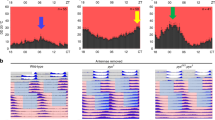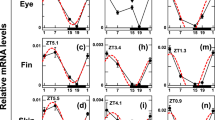Abstract
Morning and evening circadian oscillators control the bimodal activity of Drosophila in light-dark cycles. The lateral neurons evening oscillator (LN-EO) is important for promoting diurnal activity at dusk. We found that the LN-EO autonomously synchronized to light-dark cycles through either the cryptochrome (CRY) that it expressed or the visual system. In conditions in which CRY was not activated, flies depleted for pigment-dispersing factor (PDF) or its receptor lost the evening activity and displayed reversed PER oscillations in the LN-EO. Rescue experiments indicated that normal PER cycling and the presence of evening activity relied on PDF secretion from the large ventral lateral neurons and PDF receptor function in the LN-EO. The LN-EO thus integrates light inputs and PDF signaling to control Drosophila diurnal behavior, revealing a new clock-independent function for PDF.
This is a preview of subscription content, access via your institution
Access options
Subscribe to this journal
Receive 12 print issues and online access
$209.00 per year
only $17.42 per issue
Buy this article
- Purchase on Springer Link
- Instant access to full article PDF
Prices may be subject to local taxes which are calculated during checkout






Similar content being viewed by others
References
Dunlap, J.C., Loros, J.J. & DeCoursey, P.J. Chronobiology. Biological Timekeeping (Sinauer Associates, Sunderland, Massachusetts, 2004).
Matsumoto, A., Matsumoto, N., Harui, Y., Sakomoto, M. & Tomioka, K. Light and temperature cooperate to regulate the circadian locomotor rhythm of wild type and period mutants of Drosophila melanogaster. J. Insect Physiol. 44, 587–596 (1998).
Majercak, J., Sidote, D., Hardin, P.E. & Edery, I. How a circadian clock adapts to seasonal decreases in temperature and day length. Neuron 24, 219–230 (1999).
Rieger, D., Stanewsky, R. & Helfrich-Förster, C. Cryptochrome, compound eyes, H-B eyelets and ocelli play different roles in the entrainment and masking pathway of the locomotor activity rhythm in the fruit fly Drosophila melanogaster. J. Biol. Rhythms 18, 377–391 (2003).
Stoleru, D. et al. The Drosophila circadian network is a seasonal timer. Cell 129, 207–219 (2007).
Shafer, O.T., Helfrich-Forster, C., Renn, S.C. & Taghert, P.H. Reevaluation of Drosophila melanogaster's neuronal circadian pacemakers reveals new neuronal classes. J. Comp. Neurol. 498, 180–193 (2006).
Helfrich-Förster, C. et al. Development and morphology of the clock gene–expressing lateral neurons of Drosophila melanogaster. J. Comp. Neurol. 500, 47–70 (2007).
Emery, P. et al. Drosophila CRY is a deep brain circadian photoreceptor. Neuron 26, 493–504 (2000).
Klarsfeld, A. et al. Novel features of cryptochrome-mediated photoreception in the brain circadian clock of Drosophila. J. Neurosci. 24, 1468–1477 (2004).
Picot, M., Cusumano, P., Klarsfeld, A., Ueda, R. & Rouyer, F. Light activates output from evening neurons and inhibits output from morning neurons in the Drosophila circadian clock. PLoS Biol. 5, e315 (2007).
Benito, J., Houl, J.H., Roman, G.W. & Hardin, P.E. The blue-light photoreceptor cryptochrome is expressed in a subset of circadian oscillator neurons in the Drosophila CNS. J. Biol. Rhythms 23, 296–307 (2008).
Yoshii, T., Todo, T., Wulbeck, C., Stanewsky, R. & Helfrich-Forster, C. Cryptochrome is present in the compound eye and a subset of Drosophila's clock neurons. J. Comp. Neurol. 508, 952–966 (2008).
Dubruille, R. & Emery, P. A plastic clock: how circadian rhythms respond to environmental cues in Drosophila. Mol. Neurobiol. 38, 129–145 (2008).
Grima, B., Chélot, E., Xia, R. & Rouyer, F. Morning and evening peaks of activity rely on different clock neurons of the Drosophila brain. Nature 431, 869–873 (2004).
Stoleru, D., Peng, P., Agosto, J. & Rosbash, M. Coupled oscillators control morning and evening locomotor behavior of Drosophila. Nature 431, 862–868 (2004).
Stoleru, D., Peng, Y., Nawathean, P. & Rosbash, M. A resetting signal between Drosophila pacemakers synchronizes morning and evening activity. Nature 438, 238–242 (2005).
Stanewsky, R. et al. The cryb mutation identifies cryptochrome as a circadian photoreceptor in Drosophila. Cell 95, 681–692 (1998).
Emery, P., Stanewsky, R., Hall, J.C. & Rosbash, M. A unique circadian-rhythm photoreceptor. Nature 404, 456–457 (2000).
Dolezelova, E., Dolezel, D. & Hall, J.C. Rhythm defects caused by newly engineered null mutations in Drosophila's cryptochrome gene. Genetics 177, 329–345 (2007).
Shang, Y., Griffith, L.C. & Rosbash, M. Light-arousal and circadian photoreception circuits intersect at the large PDF cells of the Drosophila brain. Proc. Natl. Acad. Sci. USA 105, 19587–19594 (2008).
Helfrich-Förster, C. et al. The extraretinal eyelet of Drosophila: development, ultrastructure and putative circadian function. J. Neurosci. 22, 9255–9266 (2002).
Malpel, S., Klarsfeld, A. & Rouyer, F. Larval optic nerve and adult extra-retinal photoreceptors sequentially associate with the clock neurons during Drosophila brain development. Development 129, 1443–1453 (2002).
Veleri, S., Rieger, D., Helfrich-Forster, C. & Stanewsky, R. Hofbauer-Buchner eyelet affects circadian photosensitivity and coordinates TIM and PER expression in Drosophila clock neurons. J. Biol. Rhythms 22, 29–42 (2007).
Helfrich-Förster, C., Winter, C., Hofbauer, A., Hall, J.C. & Stanewsky, R. The circadian clock of fruit flies is blind after elimination of all known photoreceptors. Neuron 30, 249–261 (2001).
Renn, S.C., Park, J.H., Rosbash, M., Hall, J.C. & Taghert, P.H. A pdf neuropeptide gene mutation and ablation of PDF neurons each cause severe abnormalities of behavioral circadian rhythms in Drosophila. Cell 99, 791–802 (1999).
Hyun, S. et al. Drosophila GPCR Han is a receptor for the circadian clock neuropeptide PDF. Neuron 48, 267–278 (2005).
Lear, B.C. et al. A G protein–coupled receptor, groom-of-PDF, is required for PDF neuron action in circadian behavior. Neuron 48, 221–227 (2005).
Mertens, I. et al. PDF receptor signaling in Drosophila contributes to both circadian and geotactic behaviors. Neuron 48, 213–219 (2005).
Wu, Y., Cao, G. & Nitabach, M.N. Electrical silencing of PDF neurons advances the phase of non-PDF clock neurons in Drosophila. J. Biol. Rhythms 23, 117–128 (2008).
Peng, Y., Stoleru, D., Levine, J.D., Hall, J.C. & Rosbash, M. Drosophila free-running rhythms require intercellular communication. PLoS Biol. 1, e13 (2003).
Lin, Y., Stormo, G.D. & Taghert, P.H. The neuropeptide PDF coordinates pacemaker interactions in the Drosophila circadian system. J. Neurosci. 24, 7951–7957 (2004).
Shafer, O.T. et al. Widespread receptivity to neuropeptide PDF throughout the neuronal circadian clock network of Drosophila revealed by real-time cyclic AMP imaging. Neuron 58, 223–237 (2008).
Wülbeck, C., Grieshaber, E. & Helfrich-Forster, C. Pigment-dispersing factor (PDF) has different effects on Drosophila's circadian clocks in the accessory medulla and in the dorsal brain. J. Biol. Rhythms 23, 409–424 (2008).
Yoshii, T. et al. The neuropeptide pigment-dispersing factor adjusts period and phase of Drosophila's clock. J. Neurosci. 29, 2597–2610 (2009).
Hanai, S. & Ishida, N. Entrainment of Drosophila circadian clock to green and yellow light by Rh1, Rh5, Rh6 and CRY. Neuroreport 20, 755–758 (2009).
Helfrich-Förster, C. The period clock gene is expressed in central nervous system neurons which also produce a neuropeptide that reveals the projections of circadian pacemaker cells within the brain of Drosophila melanogaster. Proc. Natl. Acad. Sci. USA 92, 612–616 (1995).
Park, J.H. et al. Differential regulation of circadian pacemaker output by separate clock genes in Drosophila. Proc. Natl. Acad. Sci. USA 97, 3608–3613 (2000).
Taghert, P.H. et al. Multiple amidated neuropeptides are required for normal circadian locomotor rhythms in Drosophila. J. Neurosci. 21, 6673–6686 (2001).
Kaneko, M., Helfrich-Förster, C. & Hall, J.C. Spatial and temporal expression of the period and timeless genes in the developing nervous system of Drosophila: newly identified pacemaker candidates and novel features of clock gene product cycling. J. Neurosci. 17, 6745–6760 (1997).
Picot, M., Klarsfeld, A., Chélot, E., Malpel, S. & Rouyer, F. A role for blind DN2 clock neurons in temperature entrainment of the Drosophila larval brain. J. Neurosci. 29, 8312–8320 (2009).
Sheeba, V. et al. Large ventral lateral neurons modulate arousal and sleep in Drosophila. Curr. Biol. 18, 1537–1545 (2008).
Emery, P., So, W.V., Kaneko, M., Hall, J.C. & Rosbash, M. CRY, a Drosophila clock and light-regulated cryptochrome, is a major contributor to circadian rhythm resetting and photosensitivity. Cell 95, 669–679 (1998).
Fernández, M.P., Berni, J. & Ceriani, M.F. Circadian remodeling of neuronal circuits involved in rhythmic behavior. PLoS Biol. 6, e69 (2008).
Sheeba, V., Gu, H., Sharma, V.K., O'Dowd, D.K. & Holmes, T.C. Circadian- and light-dependent regulation of resting membrane potential and spontaneous action potential firing of Drosophila circadian pacemaker neurons. J. Neurophysiol. 99, 976–988 (2008).
Mrosovsky, N. & Hattar, S. Diurnal mice (Mus musculus) and other examples of temporal niche switching. J. Comp. Physiol. A Neuroethol. Sens. Neural Behav. Physiol. 191, 1011–1024 (2005).
Doyle, S.E., Yoshikawa, T., Hillson, H. & Menaker, M. Retinal pathways influence temporal niche. Proc. Natl. Acad. Sci. USA 105, 13133–13138 (2008).
Aton, S.J., Colwell, C.S., Harmar, A.J., Waschek, J. & Herzog, E.D. Vasoactive intestinal polypeptide mediates circadian rhythmicity and synchrony in mammalian clock neurons. Nat. Neurosci. 8, 476–483 (2005).
Blanchardon, E. et al. Defining the role of Drosophila lateral neurons in the control of circadian activity and eclosion rhythms by targeted genetic ablation and PERIOD protein overexpression. Eur. J. Neurosci. 13, 871–888 (2001).
Bergmann, A., Agapite, J., McCall, K. & Steller, H. The Drosophila gene hid is a direct molecular target of Ras-dependent survival signaling. Cell 95, 331–341 (1998).
Hamblen, M. et al. Germ-line transformation involving DNA from the period locus in Drosophila melanogaster: overlapping genomic fragments that restore circadian and ultradian rhythmicity to per0 and per- mutants. J. Neurogenet. 3, 249–291 (1986).
Acknowledgements
We thank M. Boudinot for the FaasX software and ImageJ plugins, G. Levesque for helping with the behavioral setup, O. Lenoir and C. Lancelin for preliminary behavioral experiments and C. Vias for her help with dissections. We thank J. Champagnat for his strong support and M. Rosbash, Y. Shang and the members of the Rouyer laboratory for their comments on the manuscript. We are grateful to M. Ahmad, J. Hall, J. Kim, M. Rosbash, R. Stanewsky, P. Taghert and R. Ueda for providing material, stocks and reagents. This work was supported by Agence Nationale de la Recherche 'Neurosciences, neurologie et psychiatrie' and the European Union 6th framework project 'EUCLOCK'. P.C. was supported by EUCLOCK, M.P. by Ministère de l'Enseignement Supérieur et de la Recherche and Fondation pour le Recherche Médicale, B.R. by Ministère de l'Enseignement Supérieur et de la Recherche and Association pour la Recherche sur le Cancer, and F.R. by Institut National de la Santé et des Etudes et Recherches Médicale.
Author information
Authors and Affiliations
Contributions
P.C., A.K. and F.R. conceived and designed the experiments. P.C., A.K. and E.C. performed the experiments and analyzed the data. M.P. contributed to behavioral analyses. B.R. contributed to microscopy analysis. P.C., A.K. and F.R. wrote the paper.
Corresponding author
Supplementary information
Supplementary Text and Figures
Supplementary Figures 1–6 and Supplementary Tables 1–3 (PDF 1372 kb)
Rights and permissions
About this article
Cite this article
Cusumano, P., Klarsfeld, A., Chélot, E. et al. PDF-modulated visual inputs and cryptochrome define diurnal behavior in Drosophila. Nat Neurosci 12, 1431–1437 (2009). https://doi.org/10.1038/nn.2429
Received:
Accepted:
Published:
Issue Date:
DOI: https://doi.org/10.1038/nn.2429
This article is cited by
-
The HisCl1 histamine receptor acts in photoreceptors to synchronize Drosophila behavioral rhythms with light-dark cycles
Nature Communications (2019)
-
Hub-organized parallel circuits of central circadian pacemaker neurons for visual photoentrainment in Drosophila
Nature Communications (2018)



